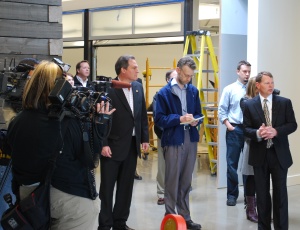The nation's buildings and infrastructure will become more efficient, significantly reducing greenhouse gas emissions and cutting energy consumption, according to a new green construction plan released recently by the Associated General Contractors of America.

The plan outlines measures designed to stimulate demand for green construction projects, boost infrastructure capacity, and improve building efficiency and green construction practices.
�Green construction holds the promise of delivering some of the most sweeping environmental improvements our country has ever experienced,� says David D�Hondt, executive vice president of the association's Washington state chapter. �The reality is that you can�t simply wish for a greener future, you have to build it.�
The plan, called �Building a Green Future,� identifies measures public officials, developers and the construction community must take to lessen the impact of our built environment on our natural environment. Measures in the plan include doubling existing energy efficiency tax credits for commercial buildings; passing the Building Star program that invests $6 billion in improving the efficiency of commercial buildings this year; and speeding reviews and boosting local tax credits for green building projects.
D�Hondt says the plan also calls for public building projects to incorporate state of the art environmental solutions and for the federal government to make pragmatic investments in research and technology. It makes it easier to launch new transit projects, shifts cargo traffic to energy efficient barges and accelerates federal approval for new transportation projects in congested corridors. And it calls for making the level of transportation investments virtually every expert agrees are needed to improve capacity and reduce traffic.
The plan also calls for faster approval for new sustainable forms of power generation, including nuclear, wind and geothermal power facilities. It tackles the environmental and health threats posed by aging and leaky clean and waste water systems. And it urges contractors to recycle more building materials and cut waste while making it easier for construction firms and building owners to green their day-to-day operations.
D�Hondt says that the plan was needed to reduce the impact the nation�s built environment has on the natural environment. He notes, for example, that buildings contribute 35% of CO2 emissions while clogged roads and transit systems account for 27% of domestic energy consumption, 27% of greenhouse gas emissions and 2.8 billion gallons of wasted fuel each year.
But by taking advantage of new green building components, infrastructure management technology and environmentally building practices, the environmental performance of the nation�s built structures could be significantly improved, D�Hondt says. He notes that researchers estimate that CO2 emissions from the transportation sector alone could be cut by 30% with the right combination of new technology and capacity.
The chapter executive unveiled the plan after a tour of construction at a green building in Seattle. The new structure will serve as local construction firm McKinstry�s incubator space for start-up green construction technology firms. Citing that company�s recent successes, D�Hondt says that while the plan would deliver significant environmental benefits, it also would provide new opportunities for the nation�s hard-hit construction firms.
He says new city-by-city construction employment figures the association recently released show how needed those new opportunities are. D�Hondt says that the Seattle metro area lost 21% (16,000) of its construction jobs between March 2009 and 2010. He adds that each of Washington�s 11 major metro areas lost construction jobs last year, with Bellingham losing the largest portion, 25% (1,800 jobs).
�While this plan will clearly lead to major environmental improvements, it also will give a much-needed boost to the hard-hit construction industry,� D�Hondt says. �The goal is clear, by next Earth Day make sure that we all can breathe easier, work more and earn a good living.�


Post a comment to this article
Report Abusive Comment